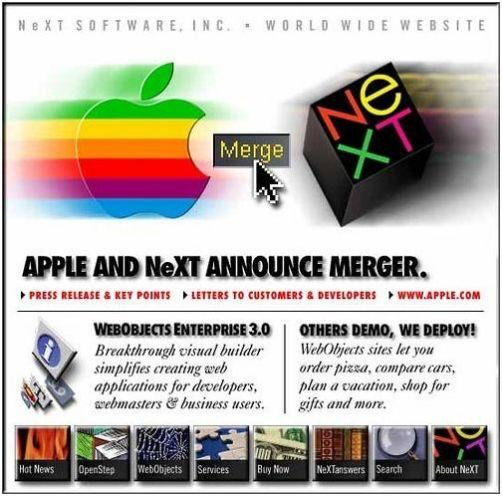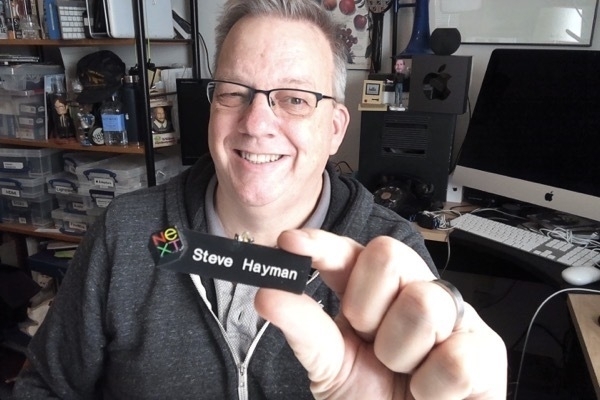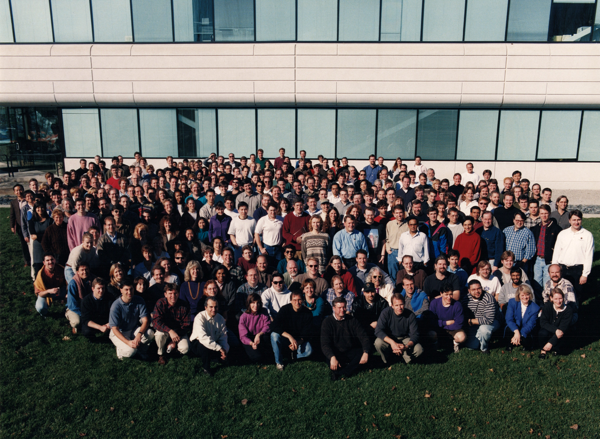Apple + NeXT, 25 years ago today.

25 years ago today, I was a field systems engineer for NeXT, one of three NeXT employees in Canada - and our family was in Scranton, Pennsylvania, introducing a three week old baby to his grandmother.
Nobody had reliable cell phones back then, so most messaging was done through a voice mail system called Audix, and somehow I still remember the number. 1-800-345-5588. I dialled it the other day. Number not in service. But I can still dial it quickly.
So anyway, we got a sudden Audix message. Urgent. Everyone must dial in at 2 PM. I went looking for a reliable land line for the call, not having much idea what it was about, and somehow wound up on a pay phone at the Steamtown Railroad Museum. (which I kind of wanted to visit anyway.)
And there, we learned that NeXT had agreed to be acquired by Apple for $400,000,000.
In retrospect, the tech involved in the merger wound up being so one-sided that many people say “NeXT actually bought Apple for negative $400,000,000.” A few years later, something like 70% of Apple’s VPs were ex-NeXT people.
I was floored. I didn’t expect this at all.
NeXT was struggling. Our founder, Steve Jobs, seemed to be spending all his time at his other company, Pixar, and although we just just eked out our first quarterly operating profit (mostly based on selling WebObjects, a Java application server) we weren’t exactly setting the world on fire.
Here’s the sort of thing NeXT was selling at the time - a press release from three weeks before the merger, touting CyberSlice, a revolutionary new system for (get this!) ordering pizza from your computer. (WebObjects was also powering the Disney and Dell online stores, and Steve had even demoed using it to buy a plane ticket through a web browser. Heady stuff for the mid-1990s.)
"CyberSlice has enabled any small or large pizza provider to get online," said Steven P. Jobs, Chairman and CEO of NeXT Software. "NeXT is excited to provide the enabling technology to CyberSlice, which combines fun with an innovative business concept. The success of CyberSlice shows the versatility of WebObjects in creating and deploying consumer web applications that are both sophisticated and original."
It must have been killing Steve Jobs that his vision of a revolutionary new workstation and operating system for higher education hadn’t panned out and that he was now reduced to selling enterprise server software for $50,000 a copy.
Apple was seemingly caught in a death spiral too and was getting awfully close to running out of money.
two weeks earlier
Two weeks earlier, I’d got a call from a former NeXT colleague Barb, who’d gone to work for Apple. She wanted to know if I wanted to come along.
“No thank you”, I replied politely, when what I was really thinking was “What, that bunch of losers? Why would I go there? They’re the only company going out of business faster than WE are.”
But the merger happened anyway, and Barb called me about a minute after it was announced to say “Well, we really wanted to hire you, so this is the only plan we could think of.”
I always wondered if the message of “We really need to hire Steve from NeXT” got garbled somehow.
shortly thereafter
Barb called and invited me to visit Apple’s office in Markham to “show us what the heck it was we just bought.”
What Apple was most interested in was NeXT’s NeXTSTEP operating system that originally came with the NeXT cube but had been ported to run on Intel systems as well. I wasn’t even using that day-to-day any more; most of my work was using WebObjects on Windows NT. But I managed to reinstall NeXTSTEP on my Toshiba Tecra, and took that up to Markham for a demo to the Apple team.
I remember struggling to get my laptop to work with their weird mutant boardroom projector, and thinking “geez, I hope this works.” and I wasn’t just thinking about the projector.
Ultimately we got it to work at a cramped 640x480 resolution and I was able to show off NeXTSTEP, Unix, Interface Builder and (horrors) the Terminal program, which was pretty much the opposite of what Apple had been providing.
Everybody at NeXT was so unclear that this merger was going to work that we all handed out our NeXT business cards for as long as those phone numbers and emails still worked. (Remind me to write up my “I was steve@next.com” story some time too.)
eventually all was well.
It worked out OK, though. The merger happened at a historic low point for Apple, and once Steve Jobs came back as CEO, an incredible technical and business turnaround began.
NeXT’s software and hardware became the foundation of everything Apple made. The NeXTSTEP operating system - which NeXT was just about to shelve, until a midlevel NeXT guy John Landwehr (hi John! How are things at Adobe?) cold-called Apple’s CTO Ellen Hancock to ask if they needed a robust operating system because Mac OS was really shaky - became the foundation of Mac OS X; NeXT’s Project Builder and Interface Builder became Xcode; NeXT’s love of the Objective-C language eventually created Swift.
And, all that technology that I started learning when I bought my $11,000 NeXT cube in Indiana in 1988 now runs on my phone. And my watch! On my wrist. Objective-C and NeXTSTEP runs on my wrist today. Crazy.
And here we are. It’s been a pretty amazing run.
The three week old baby turned out to be a fine young man too.

My NeXT badge, and over my shoulder, my NeXT cube.
the people
At the time of the merger, NeXT had about 400 employees, and Apple had only a few thousand. Today. Apple has 160,000 people. I’m curious how many of the NeXT crew are still here. I know about a dozen, and I’m sure there are more. 100 maybe? Who knows. We’ve all been incredibly lucky.
PS. This is a photo of the last ever gathering of NeXT employees before the merger was legally finalized. To my great regret, I was not able to get out to NeXT’s HQ in Redwood City for this picture, but it sure brings back a lot of memories.
